The Origins of Black Cake / Caribbean Rum Fruit Cake
Black cake, also known as Caribbean rum fruit cake, holds a cherished place in the culinary traditions of the Caribbean. Often served during Christmas, weddings, and other celebrations, it is a rich, dense, and flavorful cake made with rum-soaked dried fruits and spices. Its history, deeply rooted in colonialism and cultural blending, reflects the diverse influences that shaped the Caribbean.
Table of Contents
The Historical Roots of Black Cake
Black cake has its origins in the European plum pudding or Christmas pudding, a dessert that gained popularity in England during the 16th and 17th centuries. European settlers and colonizers brought their traditions, including recipes for fruit-based desserts, to the Caribbean. Over time, these recipes were adapted to local ingredients and techniques, giving rise to black cake.
In the Caribbean, enslaved Africans, who were skilled cooks and bakers, played a critical role in transforming the European dessert into what we know today. They infused the dish with African culinary techniques and flavors, creating a new version that better reflected the region’s climate and ingredients.
Key Ingredients and Their Significance
Rum: A central ingredient in black cake, rum’s inclusion is tied to the Caribbean’s colonial history. Sugarcane, introduced by European colonizers, became a dominant crop in the Caribbean. The byproduct of sugarcane processing, molasses, was used to produce rum, which became an integral part of Caribbean culture and cuisine.
Dried Fruits: Fruits like mixed peel, raisins, prunes, and cherries are soaked in rum—sometimes for months—to create the cake’s distinctive flavor. The practice of soaking fruits is a Caribbean adaptation of the British tradition of incorporating dried fruits into Christmas pudding.
Spices: Spices such as cinnamon, nutmeg, and allspice reflect the Caribbean’s position as a hub of the spice trade. These warm spices give black cake its signature taste and aromatic appeal.
The Cultural Evolution of Black Cake
As Caribbean communities blended African, European, and indigenous influences, black cake evolved to embody the region’s unique identity. Each island has its variations and preferences. For example:
In Jamaica, black cake is often darker and contains a generous amount of burnt sugar, known as “browning,” for color and depth of flavor.
In Trinidad and Tobago, the cake is sometimes lighter but equally rich, with a focus on rum-soaked fruits.
Black cake is more than just a dessert; it is a symbol of resilience and creativity. It represents the blending of cultures and the ability to adapt and thrive in challenging circumstances.
Black Cake in Modern Times
Today, black cake remains a vital part of Caribbean identity. It is baked during special occasions, especially Christmas, with each family passing down cherished recipes through generations. The cake’s preparation is often a communal activity, with family members working together to soak fruits, mix batter, and bake.
Its influence has spread beyond the Caribbean, becoming a popular treat in diaspora communities around the world. Black cake is a testament to the Caribbean’s rich history and cultural diversity, offering a taste of tradition in every bite.
Before I get to the recipe I would like to thank all the wonderful readers of my blog, especially those who have taken the time to send me such wonderful emails telling me how much you love my blog and sharing your personal stories with me. You inspire me!
I now present the auspicious and truly ubiquitous Trinidad black cake. The Caribbean-rum-fruit cake trumps all other cakes. What makes it so special and so beloved? You can say that it’s the fruits, the butter, or the sugar, but I am convinced that it’s the rum. The rum elevates it to a level that makes you giddy with happiness. No wonder Trinidad was named the happiest country in the world.
WHAT IS THE SECRET TO MAKING THE BEST BLACK CAKE?
I am here to eliminate all the vagaries once and for all. I did all the testing and retesting for you. No more doubts, averaging, trial and error methods. I tested it so many times that late one night while placing the cherries on one of the many cakes I made, I swore that the cake was moving. It was at that moment, I knew what it felt like to be utterly inebriated.
I settled on a recipe given to me over the phone by my mom’s friend, Aunty Lach. It was Aunty Lach’s black cake that I grew up on. Her black cakes would be the benchmark for all the other cakes I would consume in the future. None ever lived up to hers, until now. I translated her “average” measurement and suggestions into the best recipe I could create.
This is a simple recipe and in no way daunting.
THE TALE OF SOAKED FRUITS UNDER THE KITCHEN SINK
Don’t tell her I told you this, but she still has a bucket of fruits soaking under the sink here in NY. Last year, I went to her home and made black cake for her with some of the soaked fruits. She did ‘buff me up’ for saying that about her and said that she baked cakes all the time! I stand corrected my friends, I may have been too drunk with black cake to recall the facts of my childhood.
DO I NEED TO SOAK FRUITS FOR BLACK CAKE?
Because of that bucket of fruits, I grew up thinking that soaking –for years and months–is the best technique, until I tasted black cake that was made using fruits pureed the same day. I couldn’t tell the difference!
BLACK CAKE BAKING TIPS
•Fruits soaked longer result in a moister cake! If fruits are soaked only a couple of hours or days, it will result in more of a cakey texture. Still extremely delicious!
•The amount of browning used will vary depending on the brand–add gradually until the desired color is achieved.
HOW TO MAKE BLACK CAKE USING ‘UNMEASURED’ PRE-SOAKED FRUITS FROM A BUCKET?
Press play to watch video below:
What Makes Trinidad Black Cake Unique?
Trinidad black cake is a deeply aromatic and decadent dessert that embodies the spirit of celebration. Its defining characteristic is the use of rum and wine-soaked fruits, which impart a rich, moist texture and complex flavor. Add to that the distinct touch of browning—a caramelized sugar syrup—and you have a cake that tastes like joy in every bite.
Ingredients You Will Need
1. Butter – Butter is the base of the cake’s rich texture and flavor. Using high-quality butter, such as organic sweet cream salted butter, helps create a tender crumb and adds a depth of taste that complements the other ingredients.
2. Organic Raw White Sugar – The sugar provides sweetness and helps with the cake’s structure. Organic raw sugar adds a slight molasses-like flavor, enhancing the overall richness.
3. Eggs – Eggs contribute to the structure and moisture of the cake, helping bind the ingredients together. They also add richness and aid in leavening.
4. Golden or Dark Raisins – Raisins are a key component of the fruit mix, adding natural sweetness and a chewy texture. Dark raisins bring an intensified flavor and depth to the cake.
5. Currants – These tiny, tangy dried fruits contribute a burst of flavor and add complexity to the cake’s fruit blend.
6. Prunes – Prunes add natural sweetness and a deep, earthy flavor that balances the other fruits and enhances the cake’s moistness.
7. Mixed Peel – Mixed peel, made of candied citrus rind, introduces a subtle hint of citrus and a touch of bitterness that contrasts beautifully with the sweeter fruits.
8. Cherry Wine – Cherry wine is a unique ingredient that adds a touch of fruitiness and acidity to the mix. It enhances the overall flavor profile and pairs well with the rum.
9. Red Rum – Rum is the heart of Trinidad black cake. The alcohol—especially dark, rich varieties like Fernandez black label—infuses the cake with a distinctive warmth and complexity, making it a beloved holiday treat.
10. All-Purpose Flour – Flour is the structural foundation of the cake, creating a balanced texture that holds the fruits and liquids together. It’s essential for the consistency and crumb of the finished product.
11. Ground Cinnamon – Cinnamon provides a warm, sweet-spicy flavor that complements the other spices and fruits, giving the cake its signature taste.
12. Browning (Burnt Sugar) – Browning, or burnt sugar, adds a rich, dark color and a deep, caramel-like flavor to the cake. It’s an essential ingredient for achieving the dark hue and complex taste characteristic of black cake.
13. Vanilla Extract – Pure vanilla extract adds a fragrant sweetness that enhances the other flavors and adds depth to the overall taste.
14. Almond Extract – Almond extract offers a subtle, nutty flavor that complements the vanilla and other spices, adding a unique touch to the cake.
15. Baking Powder – Baking powder is used to help the cake rise and achieve a light, airy texture, balancing the dense fruit and liquor components.
Step by Step Directions – With Photos
1. In a small bowl or measuring cup mix 1 cup of cherry wine and 1 cup of rum.
2. In a small glass bowl, add raisins, currants, prunes and mixed fruit peel and 1 cup of rum and wine mixture, reserving the remaining cup to pour over the cake when it’s finished baking. Soak fruits for a few hours (minimum) or overnight…..or weeks or months…or years–whatever makes you happy.
For fruits soaked up to a year, measure 2 pounds (no liquid) and you only need to pulse about 15-20 times. It should yield about 2 1/2 cups of macerated fruit. This version (and quantity) will result in more of a pudding texture rather than a “cakey” texture. If you wish for a cakey texture, reduce amount of fruit used.
11. Pour batter into one or two prepared 8 inch round baking pans(or pans lined with parchment paper). Two will result in thin cakes–one thicker.
This recipe will also make approx. 24 cupcakes(fill cupcake tins 3/4 full and bake for less time). Cupcakes took 45 minutes in my oven.
Immediately place pans on the middle rack in the oven and bake until a toothpick or skewer, inserted in the cake, comes out clean, about 45-70 minutes. All depends on the thickness of the cake and the size of the pans used. You will need to employ your sense of sight and smell to ensure that it does not burn or over bake.
STORAGE TIPS:
Black cake can be left out on the counter but must be tightly wrapped with plastic wrap or brown paper and foil or place in a tightly covered tin pan. If at any time you see that it’s beginning to dry out, add more wine mixture over cake. Some folks soak their cake with a bottle of rum which allows it to last for many years, but unless you are an alcoholic or almost one, I won’t recommend doing that!
Trinidad Black Cake / Caribbean-Rum-Fruit-Cake
Ingredients
- ½ lb butter 2 sticks, room temperature (I used organic sweet cream salted butter), plus more for buttering pans
- ½ lb granulated sugar 1 cup
- 5 eggs room temperature, whisked
- 4 oz dark raisins packed 1/3 cup
- 4 oz currants about 1/3 cup
- 4 oz pitted prunes about 1/3 cup
- 4 oz candied mixed fruit (about 1/3 cup)
- 1 cup cherry wine I used Manischewitz
- 1 cup red rum Fernandez black label
- ½ lb all-purpose flour about 1 1/2 - 2 cups
- 2 teaspoons ground cinnamon
- 2 ½ tablespoons browning also known as burnt sugar, or more depending on the brand
- 2 teaspoons pure vanilla extract
- 1 teaspoon pure almond extract
- 2 teaspoons baking powder
Instructions
- In a small bowl or measuring cup mix 1 cup of cherry wine and 1 cup of rum.
- If you are using pre-soaked fruits skip this step. In a small glass bowl, add raisins, currants, prunes and mixed fruit peel and 1 cup of rum and wine mixture, reserving the remaining cup to pour over the cake when it's finished baking. Soak fruits for a few hours or overnight…..or weeks or months...or years, whatever makes you happy.
- When you are ready to bake the cake, puree the fruits (raisins, currants, prunes and mixed peel) in the food processor, along with the liquid it was soaked in, until it is a slightly coarse consistency. It will make about 2 cups. (I pulse about 60 times in the food processor for fruit that has soaked only 3-4 hours. I don't enjoy eating huge chunks of fruits!) If using pre-soaked fruits, measure out enough fruits to make 2 cups(without liquid), or as required.
- Preheat oven to 280 degrees F(Many times I used 325F successfully). Prepare 1 8 inch pan (for a thicker cake or two pans for a smaller cake), small gift tins or cupcake pans using the usual butter then flour or line with parchment paper. I do not butter the baking tins when using parchment paper since the parchment paper comes all the way to the top of the tin. I trim the excess paper around tin.)
- In a medium bowl, using an electric beater whisk eggs for about 30 seconds on level 2 speed.
- In a large bowl or in a kitchen aid stand mixer bowl, using the beater attachment(I also use the whisk when I cannot find the beater attachment!), cream butter and sugar until pale and fluffy, about 5-10 minutes.
- Pour eggs into the creamed mixture in a very slow and steady stream until combined.
- Mix cinnamon, flour and baking powder gradually add to creamed mixture (on level 1).
- Once flour is in, add almond and vanilla extracts, increase to level 4 speed and continue until flour mixture is light, another minute. Remove bowl from stand and scrape down sides and bottom and mix with a spoon to ensure that the batter is evenly and thoroughly combined.
- Add pureed fruits and browning to batter. Using a wooden spoon, mix in a brisk, clockwise, whipping motion until thoroughly combined(10-15 times).
- Important-place a wooden spoon upright in the middle of the batter. If it falls, you need to add ½ cup, or more flour, to the batter.
- Pour batter into two prepared 8 inch round baking pans(or pans lined with parchment paper). This recipe will also make approx. 24 cupcakes(fill cupcake tins 3/4 full and bake for less time or until toothpick comes out clean ).
- Immediately place pans on the middle rack in the oven and bake until cakes separates from the sides of the pan or until a toothpick or skewer comes out clean, about 45-70 minutes, depending on the thickness of the cake and the size of the pans. You will need to employ your sense of sight and smell to ensure that it does not burn or over bake.
- Remove cake/s from the oven. When cakes are not hot but still slightly warm, pierce with a toothpick and drizzle rum and wine mixture over cake(about 3 tablespoons at a time). Repeat the morning and evening the next day. You may continue to add more wine or rum to your liking.
Video
Notes
Nutrition
Did You Love This Recipe? Leave a Rating and Comment!
I’d love to hear your thoughts on this recipe! Don’t forget to rate it above and leave a comment below. If you have any questions, reach out via email at [email protected].
Happy baking!
Other Holiday Recipes You May Love:

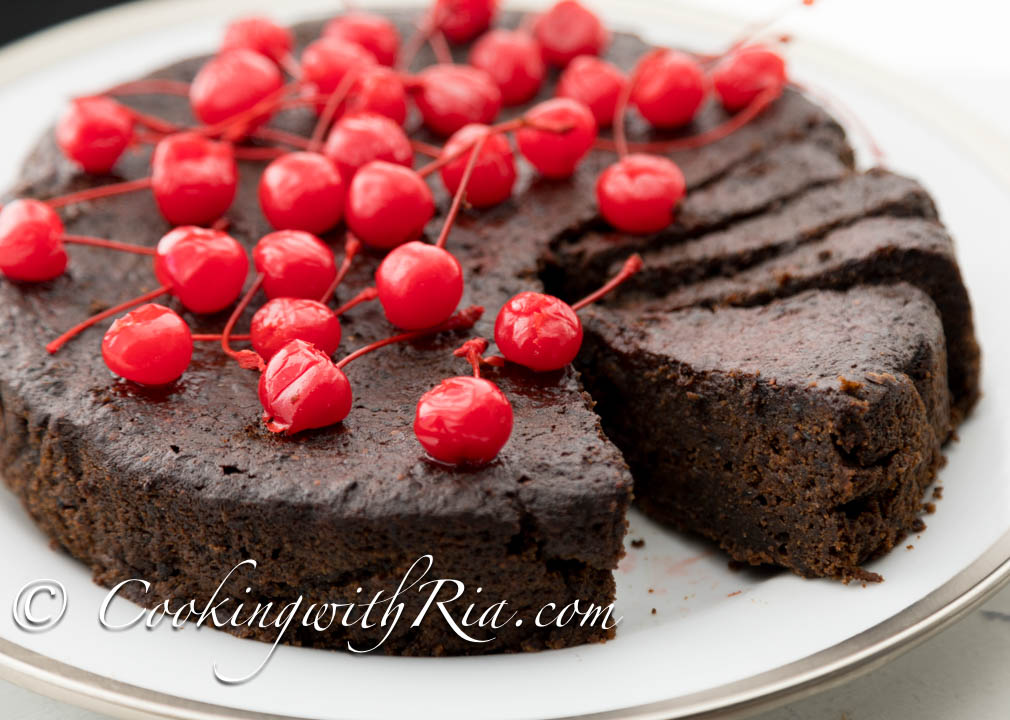



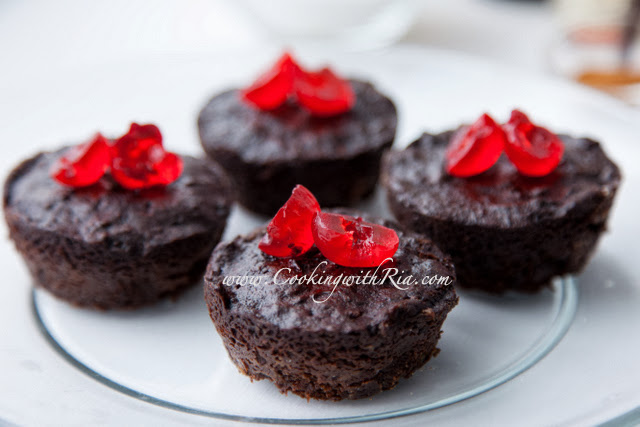


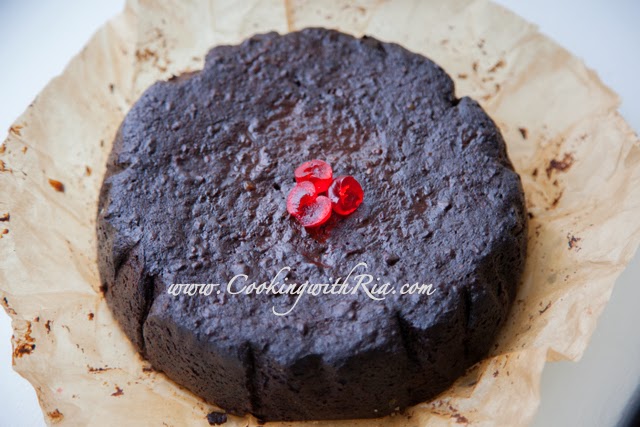
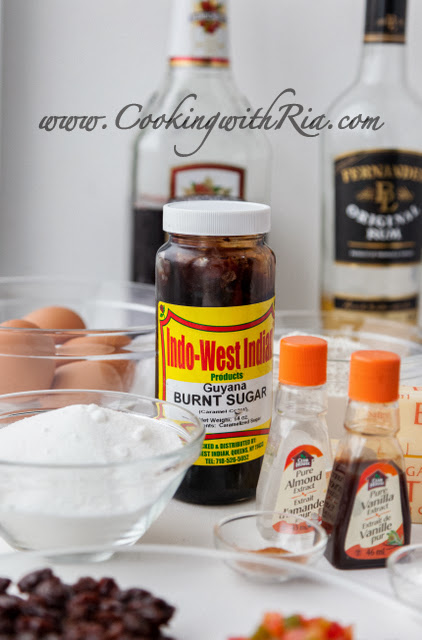
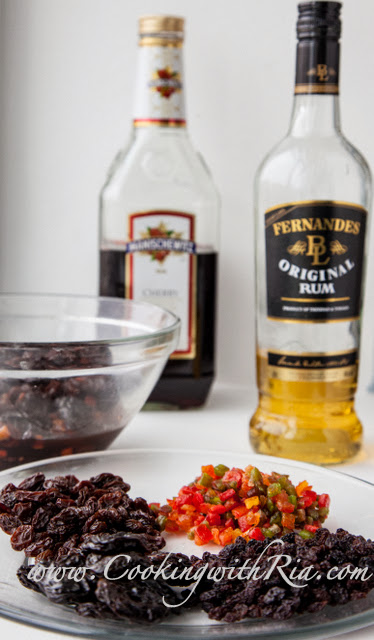











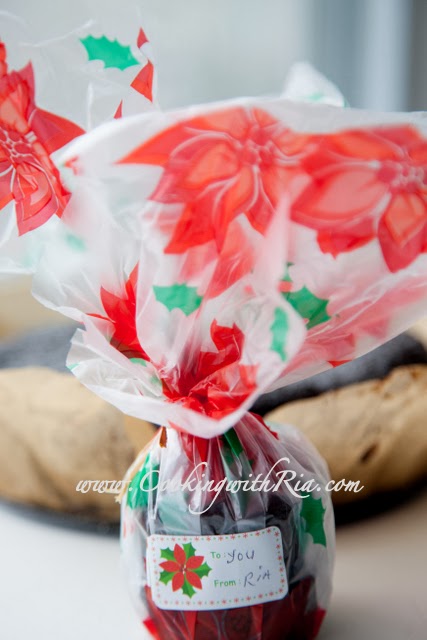

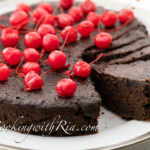

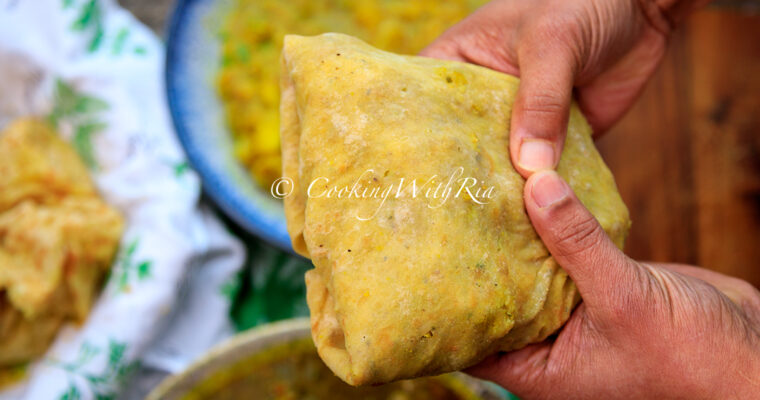

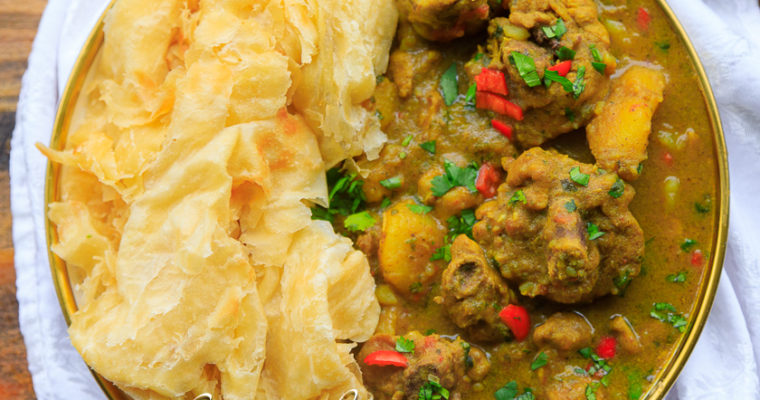

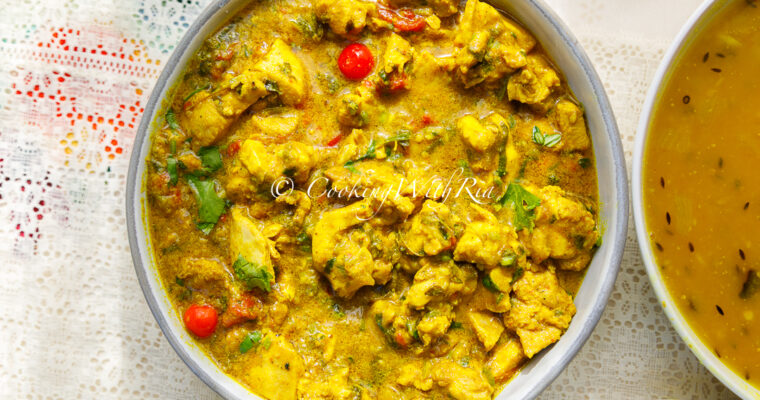
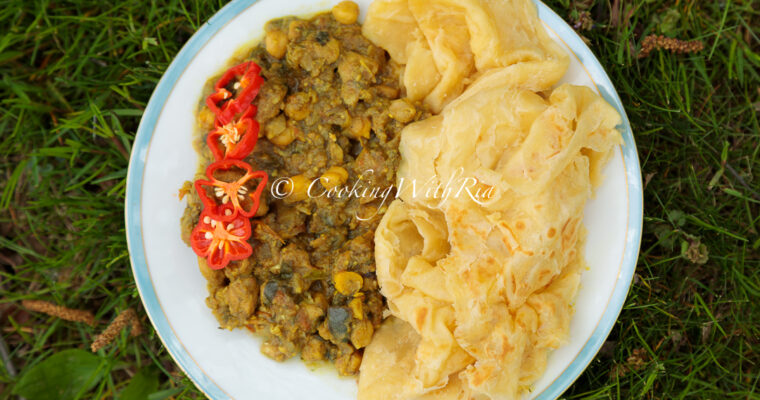
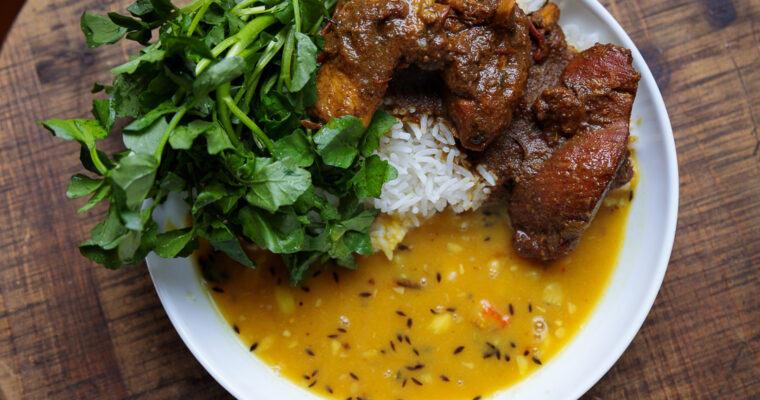
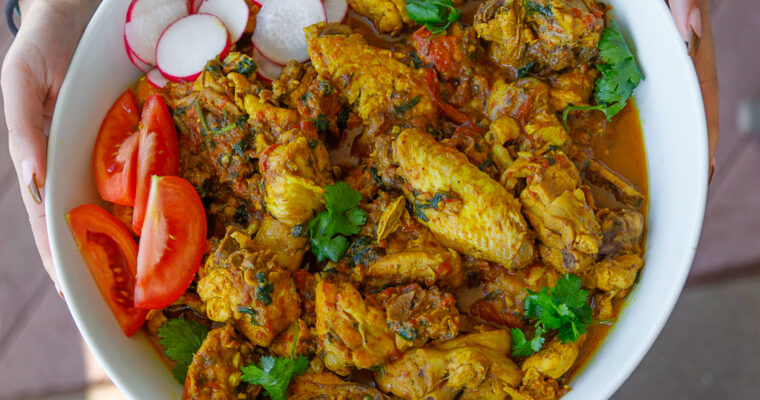



I'm excited to try this. I'm a second generation Trini and I don't have much family here, so these Trini food blogs help me feel connected to Trinidad. Thanks so much!
Just popped it in the oven! Thanks for the recipe I asked my nana from Barbados for a recipe but she has lost her old Caribbean cookbook! Bless
I just made mine last night. This recipe was a cinch and came out PERFECT! I got the thumbs up from my husband while he was still chewing! Thank you so much, please keep these classic, wonderful recipes coming.
What s red rum? can u please tell me a brand and what is the name please… also brand of cherry wine… thank u
Very nice recipe. will be using it the next time I'm making black cake.
Great Recipe
Thanks for the recipe put mines in the oven bout 20mins ago. Can't wait to taste it.😋😊😊
Hi
I have been using this recipe your the last Four years
It's delicious and very easy to prepare
Thank you Ria
Happy holidays
I love this method of black fruit cake
Thanks RIA for your perfect explainable recipe of Christmas black cake..as a Trini in Toronto it warms my heart (and feet)thanks
Cherry Ann Mendez
Hi
I have been using this recipe your the last Four years
It's delicious and very easy to prepare
Thank you Ria
Happy holidays
I was asked to make this cake again for Thanksgiving by my family. They don't want to wait for Christmas! Thank you for sharing this recipe.
Cake was delicious. Broke apart somewhat when cut though. Maybe it needed more fruit or flour. Will tweak it a bit but definitely making it again
My very first time making a black cake and this recipe was super easy .